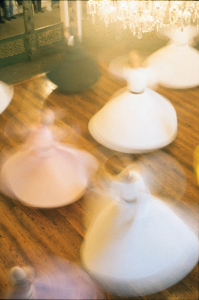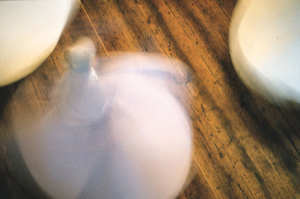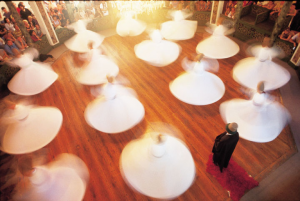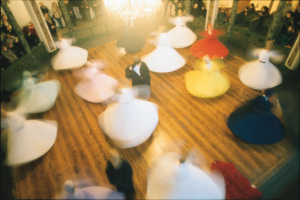 The flutists, drummers, chanters, and choir are developed into an ensemble called “Mutrip”. The Mutrip takes its place in the front part of the Sema chamber. Directly across from the entrance to the chamber is the sheepskin (called the post) of the sheik, the spiritual master. The line between the sheepskin and the entrance is called the equatorial line. This is the shortest path to unity, reaching reality. It is never stepped on by anyone but the sheik.
The flutists, drummers, chanters, and choir are developed into an ensemble called “Mutrip”. The Mutrip takes its place in the front part of the Sema chamber. Directly across from the entrance to the chamber is the sheepskin (called the post) of the sheik, the spiritual master. The line between the sheepskin and the entrance is called the equatorial line. This is the shortest path to unity, reaching reality. It is never stepped on by anyone but the sheik.
The sheikh represents Mevlana. During the ceremony the sheepskin is the greatest spiritual level. It’s red colour signifies birth and existence.
After the mutrip, the dervishes, and the sheikh have taken their places the Naat-ı Şerif is recited by the chanter.
This work whose musical notation was composed by Itri is in praise of the prophet Mohammed.
After the Naat-ı Şerif comes the sound of the drum, representing the Divine Command, “Be!” After this is a flute improvisation. The flute represents the soul given to the universe.

When the improvisation finishes the Cycle of Veled begins. In time with the prelude the sheikh and the semazens circle the Sema chamber three times. The first cycle tells of God’s creation of the sun, the moon, the stars and all inanimate creation. The second cycle signifies the creation of the vegetable world, the third, of the animal world. During the Cycle of Veled the dervishes bow to each other in front of the sheepskin post in acknowledgement of the center of Divine Truth within the heart of each.
After the Cycle of Veled the sheikh takes his place at the sheepskin. The semazens remove their cloaks, pay their respects to the sheikh, and begin turning. This represents the birth of humanity.
The semazen (whirling dervish) wears a special costume indicating the death of the ego. The sikke is a slender earth-coloured headdress which symbolizes the tombstone of the ego. The h›rka is a long black cloak representing its tomb. The tennure is a full-skirted long gown depicting the shroud.
 As the dervishes enter the circle their arms are crossed across their chests. In this position they resemble a “one”, signifying the Unity of God. During the Sema their arms are extended with the right hand opened upward, the left hand turned downward. The meaning of this is:
As the dervishes enter the circle their arms are crossed across their chests. In this position they resemble a “one”, signifying the Unity of God. During the Sema their arms are extended with the right hand opened upward, the left hand turned downward. The meaning of this is:
From God we receive, to man we give; we keep nothing to ourselves
Just as the moon and planets revolve both around their own axes and also around the sun, the semazens revolve while circling the chamber.
The Sema is a means for humans to reach Divine Reality! It is an intoxication of the soul! During the first cycle of the Sema the dervishes are viewing all the worlds. In this way they reach the grandeur and majesty of God. The lovers are freed from doubt and testify their faith in the Unity of God. In the second cycle their whole existence is dissolved within this Divine Unity. During the third cycle the lovers cleanse themselves and reach the level of maturity. In the fourth cycle they arrive at the junction of non-existence within Divine Existence.
The sheikh also enters the Sema during this last cycle. While opening one edge of his cloak with his right hand and clasping the two edges of the cloak together with his left hand he turns along the equatorial line in the center of the dervishes. This shows that he has opened his heart to all people.
hand and clasping the two edges of the cloak together with his left hand he turns along the equatorial line in the center of the dervishes. This shows that he has opened his heart to all people.
With the lone sound of the flute the sheikh returns to his post. As he reaches the post the ceremony ends with a reading from the Koran. And thus the journey ends. But in truth this was only one phase in the spiritual journey which continues every minute of the lives of the followers of The Exalted Mevlana Rumi, of all who take the path of love, of all who seek the Divine within themselves. In the words of Mevlana: If you have entered the Sema you will leave both worlds; the world of the Sema is outside both worlds

